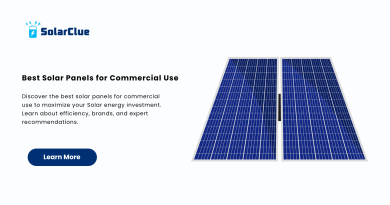How Much Energy Can Be Produced By Solar Panels?
Solar panels are a popular and effective way to generate clean energy, but understanding their power output is key to optimizing their performance. This blog explores the factors that influence solar panel performance, such as wattage rating, panel efficiency, sunlight intensity, and temperature. We’ll also provide examples and calculations to help estimate the daily, monthly, and annual energy production of a single solar panel, and explain how combining multiple panels can achieve higher overall power output.
Table of Contents
- 1 The Concept of Solar Panel Wattage and Its Significance
- 1.1 Factors Affecting Solar Panel Power Output
- 1.2 Factors Affecting Solar Panel Power Output
- 1.3 Calculating Energy Production Based on Panel Wattage and Peak Sun Hours
- 1.4 Comparing Different Solar Panel Types in Terms of Wattage
- 1.5 The Role of Location and Climate in Solar Panel Performance
- 1.6 Combining Multiple Panels for Higher Power Output
- 1.7 The Impact of Battery Storage on Energy Production
- 1.8 Conclusion
- 1.9 FAQ Section
The Concept of Solar Panel Wattage and Its Significance
What is Wattage?
- Definition: Wattage (W) is the measure of a solar panel’s power output under standard test conditions (STC), usually rated in watts. It indicates the maximum amount of electricity the panel can produce in ideal conditions.
- Significance: Higher wattage panels can generate more electricity, making them suitable for installations where space is limited, but higher energy output is required.
Factors Affecting Solar Panel Power Output
Sunlight Intensity:
- Solar Irradiance: The amount of sunlight reaching the panel affects its power output. More sunlight results in higher energy production.
Temperature:
- Temperature Coefficient: Solar panels are less efficient at higher temperatures. For every degree above 25°C, the panel’s output may decrease by a specific percentage (e.g., 0.3%-0.5%).
Shading:
- Impact of Shading: Even partial shading can significantly reduce a panel’s output. Shading can be caused by trees, buildings, or other obstructions.
Panel Efficiency:
- Efficiency Rating: This indicates how effectively a panel converts sunlight into electricity. Higher efficiency means more energy output per square meter.
Factors Affecting Solar Panel Power Output
| Factor | Impact on Power Output | Explanation |
|---|---|---|
| Wattage Rating | Directly proportional to power output | Higher wattage = more potential power generation |
| Sunlight Intensity | More sunlight = higher power output | Solar irradiance varies by location and season |
| Temperature | Higher temperature = lower power output | Panels lose efficiency as temperatures rise |
| Shading | Reduced sunlight = lower power output | Even small shadows can drastically reduce performance |
| Panel Efficiency | Higher efficiency = more power output | Efficient panels produce more energy from the same amount of sunlight |
Calculating Energy Production Based on Panel Wattage and Peak Sun Hours
Basic Calculation:
- Formula: Daily Energy Production (kWh)=Panel Wattage (kW)×Peak Sun Hours (h)
Example Calculation:
- Scenario: A 350W solar panel installed in a location that receives 5 peak sun hours per day.
- Daily Production: Daily Energy Production=0.35 kW×5 h=1.75 kWh/day
- Monthly Production: 1.75 kWh/day×30 days=52.5 kWh/month
- Annual Production: 1.75 kWh/day×365 days=638.75 kWh/year
- The Impact of Panel Efficiency on Power Output
Efficiency and Output:
- High-Efficiency Panels: These panels convert a higher percentage of sunlight into electricity, leading to more power output even if the panel size is the same as a lower-efficiency model.
- Comparison: A 350W panel with 20% efficiency will produce more electricity than a 350W panel with 15% efficiency under the same conditions.
Comparing Different Solar Panel Types in Terms of Wattage
Monocrystalline vs. Polycrystalline:
- Monocrystalline Panels: Typically have higher efficiency and wattage, making them suitable for installations with limited space.
- Polycrystalline Panels: Generally have lower efficiency and wattage, but are more cost-effective for larger installations where space is not an issue.
The Role of Location and Climate in Solar Panel Performance
Geographic Factors:
- Latitude: Solar panels in regions closer to the equator receive more direct sunlight throughout the year, resulting in higher energy production.
- Seasonal Variation: Locations with distinct seasons may experience significant fluctuations in solar power output, with higher production in summer and lower in winter.
Combining Multiple Panels for Higher Power Output
System Scaling:
- Series and Parallel Connections: Solar panels can be connected in series or parallel to increase voltage or current, respectively, allowing for a customized power output to meet specific energy needs.
- Example: Combining ten 350W panels can create a 3.5kW system, producing approximately 17.5 kWh per day in a location with 5 peak sun hours.
The Impact of Battery Storage on Energy Production
Storing Excess Energy:
- Battery Systems: By adding battery storage, excess energy produced during peak sunlight hours can be stored and used when sunlight is not available, such as at night or during cloudy periods.
- Increased Self-Consumption: Batteries help maximize the use of solar energy by storing it for later use, reducing reliance on the grid.
Conclusion
Understanding the factors that influence solar panel power output is essential for optimizing your solar energy system. By considering wattage, panel efficiency, sunlight intensity, and other factors, you can accurately estimate the energy production of your panels and maximize their performance. Whether you’re planning a small residential setup or a large-scale installation, this guide provides the knowledge you need to make informed decisions and achieve the best possible results from your solar panels.
This blog offers valuable insights into calculating and optimizing solar panel power output, helping you make the most of your solar energy investment.
Here at SolarClue®, we offer a smart, practical, and “beautiful” solution. You will be answered for all the questions related to Solar.
We provide all kinds of brands that are the Best Solar panels in India.
If you are the one who is planning for the solar power system. Don’t hesitate to contact our team!
Looking forward to empowering you with solar energy, just like hundreds of our other clients!
FAQ Section
1. What does wattage mean in relation to solar panels?
Wattage indicates the maximum power output a solar panel can produce under ideal conditions. Higher wattage panels can generate more electricity.
2. How do sunlight intensity and temperature affect solar panel power output?
More sunlight increases power output, while higher temperatures decrease it due to reduced efficiency.
3. How can I calculate the energy production of a solar panel?
Multiply the panel’s wattage by the number of peak sun hours in your location to estimate daily energy production in kWh.
4. What’s the difference between monocrystalline and polycrystalline solar panels?
Monocrystalline panels are more efficient and have higher wattage ratings, while polycrystalline panels are less efficient but more affordable.
5. How does battery storage impact solar panel energy production?
Battery storage allows excess energy generated during the day to be stored and used later, increasing self-consumption and reducing grid dependence.




